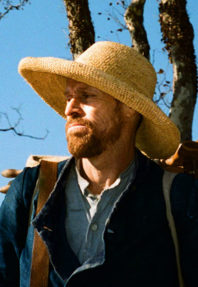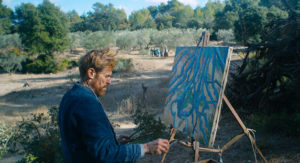
Is there anything left for movies to say about Vincent Van Gogh? He’s not only one of history’s most famous artists, but his life’s story is also one of history’s most documented. He’s been featured in countless documentaries, portrayed by great actors like Tim Roth and Kirk Douglas, and even spotlighted in one of Doctor Who’s best episodes. Yet, somehow, director Julian Schnabel finds a new way of exploring Van Gogh’s life. His film, At Eternity’s Gate, is less a story or a biopic than a meditation. One that for better and for worse, puts viewers inside the mind of an artistic genius.
At Eternity’s Gate is an arthouse film that will throw people for a loop if they’re expecting a run-of-the-mill movie experience. Schnabel isn’t concerned with familiar story structure, character arcs, and pacing. As a result, At Eternity’s Gate crawls forward at the pace of a caterpillar inching up a tree. Instead of a plot-driven film, what the director delivers is a powerful emotional experience. He wants you to feel an artist’s joy, anguish, and desires, and he does so through a series of dialogues and vignettes, often putting you in Van Gogh’s literal point of view.
The “story” centres on Van Gogh during the final days of his life. He’s poor, has few friends, and worst of all, no one admires his work. He gets by with the generosity of his brother Theo (Rupert Friend), one of the only people to support his artistic ambitions. He also enjoys his friendship with fellow artist Paul Gauguin (Oscar Isaac) who gives Van Gogh one of history’s all-time great bits of career advice. Gauguin tells him to, “Go south because the light is better.” It’s in the south of France where the artist experiences the most productive phase of his career, firing off paintings with the swiftness of a Chinese factory producing MAGA hats. And though Van Gogh is in his element creatively, he is far from fulfilled, and we watch him endure the fallout from his intense creative ambition while also battling mental illness.
At Eternity’s Gate evokes feelings from the audience in a way that only this beautiful medium can. Schnabel blends cinematography, editing, colour grading, music, and performances together to create a masterwork in empathy. This film doesn’t stop at using first person point of views to make you see the world through Van Gogh’s eyes, it manifests a tempest of emotions to make you feel the crushing fears, regrets, and anxieties weighing down his spirit. The director successfully captures the duality of a tortured artist’s existence. He creates an ebb and flow of beauty and calamity; see-saws between Van Gogh’s sense of certainty and awe of the unknown; makes us feel his creative highs and moments of despair.
In one scene, the camera glides through a field of dead sunflowers as they hang slack under a cold grey sky. But not long after, we find Van Gogh in a Malick-esque scene, basking under the golden pink hues of a setting sun. What Schnabel does so wonderfully is depict the push and pull of the creative spirit. When not immersed in his art there is a void in the protagonist that he desperately seeks to fill, and we feel every bit of his longing. In turn, when he taps into his creative spirit, the world is bathed in a life-affirming glow and there’s a palpable sense of warmth, purpose, and fulfillment. For someone like Van Gogh, existence without creative expression means enduring a living hell. And this picture does a great job expressing his most primal feelings which words can’t express.
A good portion of the film focuses on Van Gogh working through his complicated feelings about his art. This often plays out in monologues and debates with other characters. These exchanges can be on the nose, but the lack of nuance didn’t bother me. A film as untethered from a narrative structure as At Eternity’s Gate needs incisive moments of clarity to anchor the themes. These thematic signifiers are like a trail of breadcrumbs that keeps the audience from losing their way amidst the ephemeral exchanges.
I get that some people will write this movie off as a slow-paced and portentous work of self-indulgence. Those are all fair claims since this film has zero interest in adhering to cinematic conventions. Schnabel goes out of his way to break the accepted mould and use cinema’s tools to speak to his audience on a whole other wavelength. And while undoubtably offbeat, At Eternity’s Gate is also one of the year’s most rewarding films. Schnabel paints a vivid, textured, and nuanced portrait of Van Gogh’s life that will resonate with anyone who has ever embraced their creative spirit.
- Release Date: 11/23/2018



